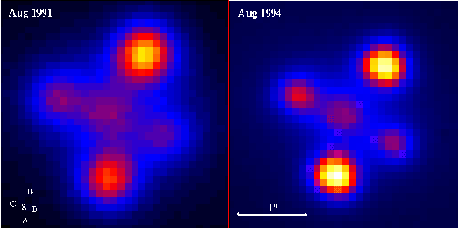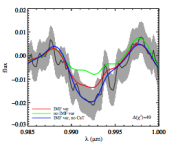- Paper title: The Emission Line Properties of Gravitationally-lensed 1.5 < z < 5 Galaxies
- Authors: Johan Richard, Tucker Jones, Richard Ellis, Daniel P. Stark, Rachael Livermore, and Mark Swinbank
- First author’s affiliation: Dark Cosmology Centre, Niels Bohr Institute, University of Copenhagen, Denmark
Introduction
Studying galaxies at high redshift helps us to understand how galaxies formed and evolved; in particular, astronomers are interested in the rates of star formation in galaxies and how these rates change with time. The metallicity of a galaxy is an important quantity for these studies because it measures how much mass has been processed by stars. This paper extends the relation between galaxy mass and metallicity to intrinsically fainter sources between redshifts or 1.5 and 5. The authors use gravitational lensing to probe this lower-luminosity population. Lensing occurs when a massive foreground object — a galaxy cluster, in this instance — magnifies and distorts the light from a background object — here, a galaxy.

Two lensed galaxies in Richard et al. NIRSPEC sample. The long arcs are the gravitationally lensed background galaxy. In addition to being distorted and magnified, the lensing has resulted in multiple images of the background galaxy, which is why you see several arcs (in the first) or an arc and a counter image (in the second). The red lines indicate the location of the slit used for spectroscopy.
Methods
After collecting the data, there are three main values that need to be calculated for the lensed background galaxy: its star formation rate (SFR), metallicity and mass.
Spectral features related to a species are indicative of the amount that species present: for example, by looking at an OIII (doubly ionized Oxygen) line, you may be able to determined how much OIII is in your source. From spectral line measurements, you can calculate the galaxy’s star formation rate (SFR) and metallicity using methods calibrated by others. In this work, the authors took spectra of the lensed background galaxies and measured the width and total flux of several emission lines. They based their calculations of the SFR on calibrations done by Kennicutt in 1998 and use the abundances of oxygen and nitrogen (relative to the abundance of hydrogen) as indicators of metallicity.
They calculate the mass of the lensed galaxies in two ways: first, by comparing galaxy models to the observed brightness at different wavelengths, and second, by looking at how spectral lines are broadened (broadening is caused by the motion of individual objects, which can be related back to the total mass of the system).
Results
The lensed background galaxies studied in this work are found to have significantly lower star formation rates but only slightly smaller metallicities than those found in the previously-studied, more luminous galaxies. The mass-metallicity relation changes less with redshift that in previous studies, but their results are consistent with the relation between mass, metallicity and SFR that was proposed by Mannucci et al. (2010).
Future work
Future surveys are likely to find large numbers of high redshift objects magnified by gravitational lensing. Studying these galaxies allows us to study relations–such as that between mass, metallicity and star formation rate–at lower masses and SFRs than might otherwise be possible.





Trackbacks/Pingbacks